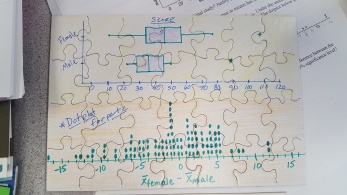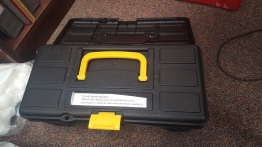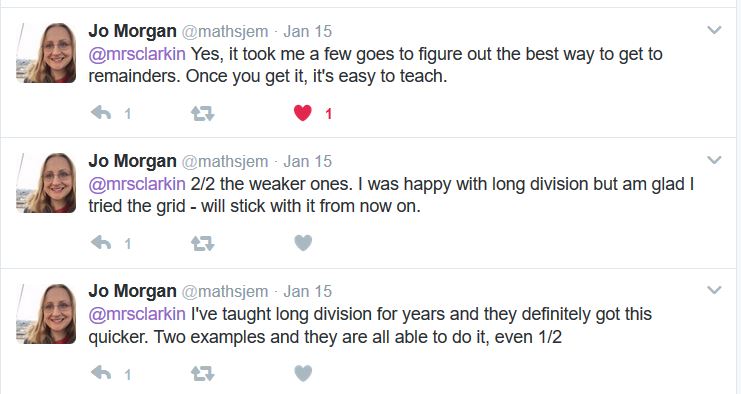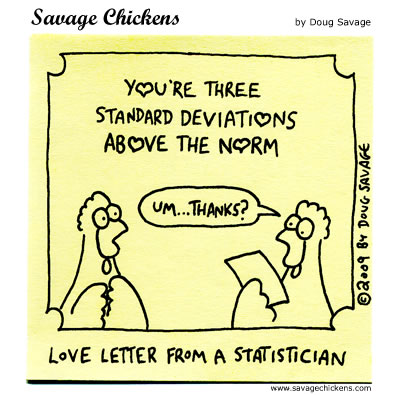If you’ve ever run into me at an educational setting and we talked about anything related to AP Stats then the book “Make It Stick” (book link) by Brown, Roediger, & McDaniel. I was first introduced to this book at the Best Practices at the AP Stats reading by Darren Starnes. I think most of us who attended ordered a book to read that summer.
*Warning though: It’s not one of those books that you can just sit down and digest quickly!
It’s definitely one that you need to read a chapter at a time and think about. So admittedly I haven’t finished the entire book. Too much good stuff that I wanted to put into practice right away (and honestly not enough time to finish it before the school year started.) But from what I gleaned I came up with the following changes that I’ve implemented into my AP Stats classes the past 2 years and I’ve seen dramatic differences. My AP scores have been great (not all 5s or anything but my kids have done well for where they are and how strong they are) AND the percentage of students who take the exam have gone up as well. In my school system the students pay to take the AP Exam and they are NOT required to take the exam either. When registration time comes along I do ask each kid individually if they have registered and if the answer is no I WANT to know why. I never pressure a kid to take the exam but I want to make sure their reason is justifiable (in other words not just because they can’t afford it or think they won’t do well but they don’t want to try.)
To be completely transparent you must know that I do teach at a high performing school where there are not a lot of free & reduced lunches and parent involvement is pretty high too. However I’ve also taught in the opposite environment and firmly believe that this CAN work in any school situation with a few adjustments. The truth is looking outside the environment KIDS ARE KIDS no matter where you teach!! My kids aren’t any smarter than the kids I’ve taught at other schools so as far as the raw material you have to work with it’s pretty much the same 🙂 It’s those external factors that we can’t always control that get in the way sometimes but as a teacher there are a lot of things that you CAN do to meet your students where they are and help them reach the SAME level as others. To be honest I think those kids who don’t have all those supports are my hardest workers and the most determined to succeed. I feel like I make the most difference to them as challenging as it may be sometimes. But I digress… here is what you probably want to know.
I’ve got a lot of info listed below so I tried to underline and section key things. Feel free to ask questions if I wasn’t clear about something. Enjoy!
Some background about my AP Stats classes:
*I have 2 types of classes for my schedule. Those that meet everyday for 50 minutes and those that meet every other day in a block for 90 minutes. Inevitably my 90 minute classes lose time in comparison so I always plan for my block class which includes our lunch shift. Any extra time in my 50 minute class time is bonus.
*Due to the loss of time for the block classes 4 years ago I went to the flipped classroom model and love it!! It helps me cover all the material in ample time (even with tons of snow days) to have at least 1.5 weeks to review.
*In our school currently we have “break” day where students go for various things like extra help, club meetings, etc.. They fall on Wednesday and while they don’t affect the block class they do reduce 3 of the other classes times that they meet to less than 50 minutes each.
*I have very competitive students and grades are often more important than learning sadly. Cheating is rampant at my school.
*Most of my students are seniors but I do get juniors and sophomores as well taking this class.
My aha moment:
Something that struck me before I even read the Make It Stick book was something I heard during the Best Practice Night at the 2015 AP Reading. I don’t even know who said it but they asked the question about why do we test the way we do given that the AP test is a cumulative test? In other words why are we surprised when kids ask us so many questions that we think they should know when we review for a midterm or the AP exam. Part of the problem is we chunk things into units and students review for that unit but often shelf that material until they plan to see it again which tends to be much later on. It was then that a light bulb went off in my head. Why am I giving unit tests? While I do some cumulative review throughout the year, why am I not testing them on cumulative material so the AP exam is just one large version of what I’ve been doing all year long? Then I started the book and the research about how people learn and retain material was supporting this idea in my head.
What I did:
There were no more unit tests or quizzes!! (And as they found out later no tests in Qtr 4 – which was focused on AP exam review.)
At the beginning of the quarter I told the students to mark their calendars with the Quiz and Test dates. (Example from last year: 1st_Qtr_16-17)
You can see from the example that it worked out the be a test every 3 weeks or so and if it wasn’t a test week then there was a quiz usually towards the end of the week. I’ll talk more about the format of these below. Key things I made sure was that I had tests on a day that was not break schedule or anything else key that was going on at school like homecoming week, etc. For my block kids I always shifted my lunch to C lunch on test days (we have 4 lunches) so they had the test the first 60 minutes, lunch, then came back for a lesson.
I told them that everything in this class was cumulative so if you wanted to know what would be on their assessments, it was fair game from everything that we’d covered so far. This means no formal review days before a test. While there would be a concentration on the most recent material, anything could be on there. We would also review throughout the year regularly.
I also told them upfront the format of every test and quiz would be the same so there were no surprises. (See later some other things I already had in place that complemented this strategy.)
The formats:
Quizzes – because I was giving these more frequently I wanted to make sure that they were quick and to the point so they could have them back fast. In my mind I never want a quiz to take more than 10-15 minutes of time so they were always right at the beginning of the class period after the warm-up. They never included anything covered the 2 days prior to the quiz (one block period) to give students the opportunity to get help and also I didn’t have to go over any homework questions or whatnot before the quiz. They knew the process so they were ready to go and didn’t try to ask last minute questions once class had started to delay the quiz. The other important thing is that I wanted them to get good, fast feedback on some possible difficult questions and really assess whether they got some of the big concepts we talked about – this meant making them low stakes in their grades. Each quiz was either 7 or 8 points and it was only 20% of their grade for the class. This way if they got a 3 or 4 on a quiz it didn’t kill their grade and they learned what they needed to do to get better.
The format: Very few questions. Never more than a front sheet of paper. Question 1 was always something like “In your own words describe…..” and I would take a difficult term or concept or something I knew there was still confusion on (or even common mistakes on previous AP tests). Question 2 was something relatively recent. Question 3 was an old item or something that used something old in what we were currently doing. Question 4 & 5 were only if necessary because the other questions were super short and not many points. (Example quizzes: Qtr 1 Quiz 2 & Qtr 3 Quiz 4)
Here was another twist. Since I announced the dates of ALL the assessments at the beginning of the quarter, kids knew when they would be out and could take the quiz in advance or take the make-up version if they were absent. The make-up version was similar but NEVER the same as the in class version. This was for the students who were absent for sickness as well. This way I could always give the quiz back the very next block class. (Being in a block schedule my kids know how I reference the A-day B-day thing so a kid in a everyday class knew that if they took a quiz on an A-day then they got it back the following A-day.) Since these quizzes were super short it was easy to grade them fast.
Tests – It was super important to me for kids to see their tests in a similar format to the AP Exam so it wasn’t foreign to them when the time came. I also needed it to be no more than 50 minutes to accommodate any class. I used the time allotted for the AP exam to guide me here. 90 minutes for 40 MC questions – this equates to approx 2.25 minutes per question. 90 minutes for 6 FR questions with more time allowed for #6. I knew I wasn’t going to put a #6 on my test so I figured 60 min for 5 FR questions – this equates to approx 12 minutes per question.
1 Test = 6 MC question and 3 FR – based on these time approximates 49.5 minutes
This was the format for EVERY test and I told the kids this BEFORE our first test (After the test I told them the time breakdown for them to understand why a 9 question test took them so long!)
Scoring: MC – 1 point each FR – 4 points each scored using a rubric so each test was raw point max 18 but I always converted these to percents to enter in my gradebook. The test/project category was 50% of their grade. (The other 30% was classwork – yes you might have inferred that I didn’t grade homework – haven’t for several years but I also flip my classroom so homework is watching the assigned video (which they did earn 5 points for each) but most of my traditional homework was now done in class in a group format. BTW I do almost everything in groups for this class which I change consistently.)
I also made a make-up version for each test which I first I thought it would be hard but since I had to keep it to this format it wasn’t that bad. Note that 2 of the 3 FR questions on my test were released old FRAPPYs so the question and rubric was already done for me (huge help for grading consistently.) We did FRAPPYs from the beginning in my class so seeing E, P and I on their tests was a no brainer.
After 2 block classes I gave back their tests. BTW for tests I ALWAYS had an answer sheet and the test. The tests NEVER left my room. I consider them secure documents and numbered them to ensure I had them all each class period. This means when I say I handed back their tests I only handed back their answer sheets with their work on it. Once I handed back their tests I took time in class to go over the correct answers for the multiple choice and some general notes about what scored an E on the FR. I also always showed them a box plot like this Sample Test Results (plus summary statistics) for them to see how they did in respect to their class and the others. Any other questions they had they need to stay after or come during break to get answered.
Needless to say kids didn’t always like their scores and it was a learning process so what I told them AFTER the first test was that they could do corrections 🙂
What are corrections?
I’ve always done these and I think they are super helpful in the learning process but since I changed up my testing I also changed up what I did for corrections a little for the grades.
*All corrections are for TESTS only.
*All corrections MUST be done after school or during break BEFORE the next test to be counted.
*Corrections must be done at school and not at home. This is the only way you’ll see the original test questions.
*Corrections for the MC must include the correct answer AND why it is correct in your own words.
*Corrections for the FR have to be what was missing and/or whatever was wrong fixed
*In 1st quarter you earn back 50% of the points you missed. 2nd quarter 40% and 3rd quarter 30%. I realized that this was an entirely new to them so I didn’t want to penalize them for a learning process. Kids that made the effort to learn from their mistake to make corrections each test ended up with grades that truly reflected their ability this way. Kids that didn’t take advantage of corrections earlier on realized this was a mistake especially when sometimes I put the same problem on a future test!
What did corrections look like for me the teacher?
Admittedly the first test correction is always chaotic. I used to restrict the dates for them to come, but with 4 sections it’s crazy to do that and keep up with grading the corrections. The first couple of times kids come with friends in bunches and we go over common mistakes everyone has as a group then the rest of the time I pop around answering individual questions. I encourage kids to help one another so that by the next few test corrections kids come together to help each other and I’m not answering as many questions.
As far as grading them, I’m walking around and helping and looking at what they did so I just need to spot check the corrections they made without me and then grade it before I leave that day. Since there are only 18 raw points max for each test I have a nice paper with the corrected score that I can add into the gradebook. (BTW in case you are wondering I have 2 assignments entered in my gradebook. One is the original test grade in % out of 100 points and the second is the Test correction extra points (out of 100) that looks like extra credit. At the end of the test correction period I fill in 0 for the extra points for those that don’t do corrections. This way I see the original and correction points on the grades and SO do the parents.)
What the kids thought:
At first they weren’t sure they were going to like it but soon after they felt comfortable knowing the format of every quiz and test before going in to take it. At least that didn’t change even if the material did. It released some testing anxiety and encouraged them to consistently look back at old things we did periodically. Kids that were very involved in extracurricular activities appreciated knowing the dates at the beginning of the quarter so they could plan when they needed to study around their games, practices, etc… When it came to midterms several kids commented that they felt most prepared for mine because we had been reviewing all along.
Most kids appreciated the opportunity to make corrections for the grade aspect but especially for the learning process. It forced them to revisit an old test and understand what they did wrong. Some admitted they wouldn’t have done that on their own, but for points it made a difference and soon kids were making corrections on their own for the weekly quizzes to study from and they didn’t get points for doing that 🙂
I know I’ve left you with a lot to read and think about. Feel free to ask me questions if you have them. In my next post I’ll tell you about why my kids & I are crazy about tickets for this class!














